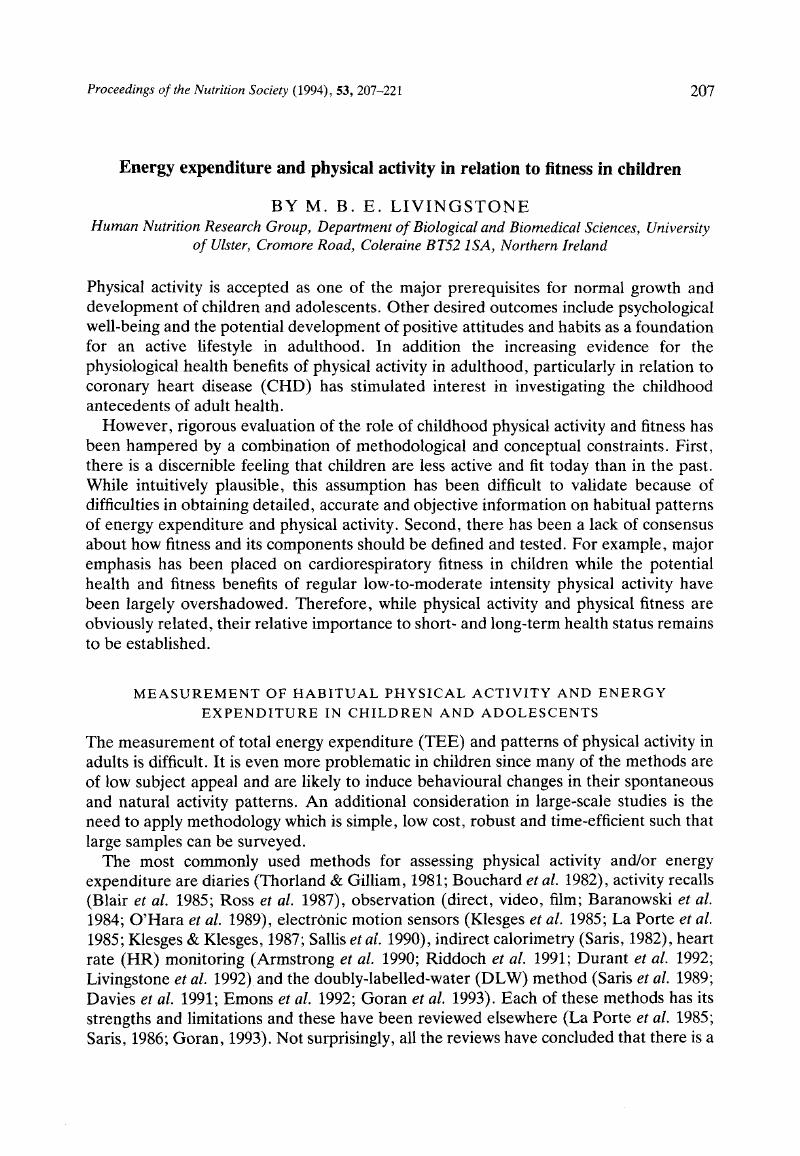Crossref Citations
This article has been cited by the following publications. This list is generated based on data provided by Crossref.
Malina, Robert M.
1996.
Tracking of Physical Activity and Physical Fitness across the Lifespan.
Research Quarterly for Exercise and Sport,
Vol. 67,
Issue. sup3,
p.
S-48.
1998.
Abstracts of Communications.
Proceedings of the Nutrition Society,
Vol. 57,
Issue. 01,
p.
1A.
Bénéfice, Eric
1998.
Physical fitness and body composition in relation to physical activity in prepubescent Senegalese children.
American Journal of Human Biology,
Vol. 10,
Issue. 3,
p.
385.
KATZMARZYK, PETER T.
MALINA, ROBERT M.
SONG, THOMAS M. K.
and
BOUCHARD, CLAUDE
1998.
Physical activity and health-related fitness in youth: amultivariate analysis.
Medicine & Science in Sports & Exercise,
Vol. 30,
Issue. 5,
p.
709.
TAYLOR, WENDELL C.
BLAIR, STEVEN N.
CUMMINGS, SHARON S.
WUN, CHUAN CHUAN
and
MALINA, ROBERT M.
1999.
Childhood and adolescent physical activity patterns and adult physical activity.
Medicine & Science in Sports & Exercise,
Vol. 31,
Issue. 1,
p.
118.
Grund, A
Vollbrecht, H
Frandsen, W
Krause, H
Siewers, M
Rieckert, H
and
Müller, MJ
2000.
No effect of gender on different components of daily energy expenditure in free living prepubertal children.
International Journal of Obesity,
Vol. 24,
Issue. 3,
p.
299.
Mast, Mareike
Asbeck, Inga
Langnäse, Kristina
Grund, Andreas
and
Müller, Manfred James
2000.
Die Kieler Adipositaspräventionsstudie (KOPS) - Ein Erfahrungsbericht.
Kindheit und Entwicklung,
Vol. 9,
Issue. 2,
p.
108.
Grund, A
Krause, H
Siewers, M
Rieckert, H
and
Müller, MJ
2001.
Is TV viewing an index of physical activity and fitness in overweight and normal weight children?.
Public Health Nutrition,
Vol. 4,
Issue. 6,
p.
1245.
Benefice, D. Garnier, E.
2001.
Habitual physical activity of Senegalese adolescent girls under different working conditions, as assessed by a questionnaire and movement registration.
Annals of Human Biology,
Vol. 28,
Issue. 1,
p.
79.
Benefice, Eric
Garnier, Denis
and
Ndiaye, Gnagna
2001.
Assessment of physical activity among rural Senegalese adolescent girls: Influence of age, sexual maturation, and body composition.
Journal of Adolescent Health,
Vol. 28,
Issue. 4,
p.
319.
Lasheras, Luisa
Aznar, Susana
Merino, Begoña
and
López, Enrique Gil
2001.
Factors Associated with Physical Activity among Spanish Youth through the National Health Survey.
Preventive Medicine,
Vol. 32,
Issue. 6,
p.
455.
Müller, M. J.
Grund, A.
Krause, H.
Siewers, M.
Bosy-Westphal, A.
and
Rieckert, H.
2002.
Determinants of fat mass in prepubertal children.
British Journal of Nutrition,
Vol. 88,
Issue. 5,
p.
545.
Livingstone, M. B. E.
Robson, P. J.
Wallace, J. M. W.
and
McKinley, M. C.
2003.
How active are we? Levels of routine physical activity in children and adults.
Proceedings of the Nutrition Society,
Vol. 62,
Issue. 3,
p.
681.
CHAN, EDDIE W. C.
2003.
RELATIONS AMONG PHYSICAL ACTIVITY, PHYSICAL FITNESS, AND SELF-PERCEIVED FITNESS IN HONG KONG ADOLESCENTS.
Perceptual and Motor Skills,
Vol. 96,
Issue. 3,
p.
787.
Melin, Alexandre
Obert, Philippe
Bonnet, Pierre
and
Courteix, Daniel
2003.
Effets du statut socioéconomique sur l'activité physique d'enfants prépubères.
Canadian Journal of Applied Physiology,
Vol. 28,
Issue. 2,
p.
190.
Chan, Eddie W. C.
Au, Eva Y. M.
Chan, Billy H. T.
Kwan, May K. M.
Yiu, Perry Y. P.
and
Yeung, Ella W.
2003.
Relations among Physical Activity, Physical Fitness, and Self-Perceived Fitness in Hong Kong Adolescents.
Perceptual and Motor Skills,
Vol. 96,
Issue. 3,
p.
787.
Rowlands, Ann V.
Ingledew, David K.
Powell, Sarah M.
and
Eston, Roger G.
2004.
Interactive effects of habitual physical activity and calcium intake on bone density in boys and girls.
Journal of Applied Physiology,
Vol. 97,
Issue. 4,
p.
1203.
Bénéfice, Eric
and
Ndiaye, Gnagna
2005.
Relationships between anthropometry, cardiorespiratory fitness indices and physical activity levels in different age and sex groups in rural Senegal (West Africa).
Annals of Human Biology,
Vol. 32,
Issue. 3,
p.
366.
Luciano, Alexandre de Paiva
Bertoli, Ciro João
Adami, Fernando
and
Abreu, Luiz Carlos de
2016.
NÍVEL DE ATIVIDADE FÍSICA EM ADOLESCENTES SAUDÁVEIS.
Revista Brasileira de Medicina do Esporte,
Vol. 22,
Issue. 3,
p.
191.
Rivera Morales, Javier
Vargas Guadarrama, Luis Alberto
and
Sotuyo, Solange
2019.
Una mirada antropológica a la resistencia física de los rarámuri.
Anales de Antropología,
Vol. 53,
Issue. 1,
p.
89.



